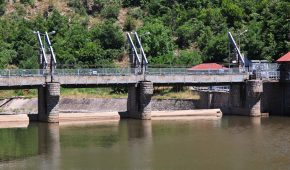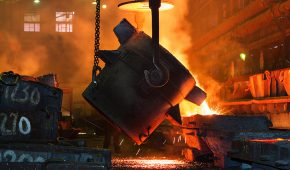Steel pipesare elements of simple construction. It may seem that their production is just as simple. In reality, however, it is different – the pipe production process requires the use of advanced equipment, as well as experience and skills. What does the production of pipes look like depending on their type?
What is the difference between welded and seamless pipes?
The pipes available in our warehouse can be divided into three main groups:
Particular types of pipes differ from each other not only in appearance and application but also in the method of their production.
The production process of welded pipes
Pipes with a seam, both longitudinal and spiral, are made of large sheet metal. The production process of pipes involves forming them into the appropriate shapes, followed by welding or seaming. The seam point is clearly visible (especially in the case of a spiral seam). This does not affect the functionality of the pipe but is quite detrimental to its aesthetics.
The longitudinal seam runs perpendicular to the edge of the sheet metal. A spiral seam is formed when the joint is made diagonally about the formed sheet metal. Such a connection is more visible, but thanks to it the pipe gains greater strength – spiral seams are most often used to connect pipes of large diameter.
Seamless pipe production process
The process of producing pipes without a visible connection point is a bit more complicated. For seamless pipes, the diagonal rolling method is used. A hole is made in the steel material. The element prepared in this way is placed between two rollers, with the axes arranged at a certain angle. To shape it into a pipe, it is rotated and pulled onto a special mandrel.
The described method is the most popular and fastest. The Calmes method is also used quite often. Its advantage is low cost and high precision. The method itself is quite simple – a square ingot is placed in a round matrix while maintaining a certain free space. An axial hole is pressed in there with a punch. Then the extender gives the material the desired shape.
What is the difference between hot-rolled, cold-rolled and drawn tubes?
Pipe production processes can be divided according to other criteria. The key factor here is the temperature that accompanies the production of steel elements. According to this division, it is possible to divide pipes into:
- hot-rolled, i.e. those in which the material used for production is heated to a temperature higher than the recrystallization temperature;
- cold-rolled, which are formed at a temperature lower than the recrystallization temperature;
- drawn, hot-rolled pipes, which in low-temperature conditions are subjected to the process of reducing the diameter.
Which pipes to choose: seamed or seamless?
Welded pipes will be the best choice where low prices and versatile use are important. They are also valued due to their high availability on the market. These advantages of seamed pipes make them most often used for the construction of industrial installations.
When is it worth choosing seamless pipes? This type of pipe is characterized by very high strength and tightness – the lack of seam is the lack of an element potentially weakening the structure. For this reason, seamless pipes are willingly chosen as an element of installations in which gases are transported.
One of the parameters that we always check before buying a steel pipe is its dimensions. There are various dimension series and units of measurement for steel pipes that are worth knowing. In the article, we present the most important information on this topic.
Wall thickness and diameter of steel pipes
The basic dimensions of steel pipes are the outer diameter and wall thickness. These parameters are standardized due to the production technology and purpose. Knowing what they are, we can easily calculate the inner diameter of the pipe. It is assumed that pipes with a diameter not exceeding 580 mm may be in a seamed or seamless version, while in the case of pipes with a larger diameter, the place of joining the edges of the sheet metal must be welded longitudinally or spirally.
The dimensions of the pipes are not random. They are assigned to dimensional series based on an established system. From a historical point of view, the dimensions of line pipes were first systematized, followed by the other types of pipe, as they were produced with the same equipment.
In Poland, the diameter range for steel pipes intended for threading was developed based on Whitworth thread. Pipe walls have a thickness that allows the thread to be cut, however, due to the forces required to cut and connect the pipes by threading, it is not practised to connect pipes with diameters larger than 4 inches in this way.
Measurement units of steel pipes
Usually, the dimensions of steel pipes are given in millimetres, but in the USA and many other countries, we may encounter a unit of measurement such as inches. In this case, two groups of pipes are distinguished – Tube and Pipe. The first type is steel pipes intended for mechanical applications and power equipment. Their dimension indicates the actual size of the outside diameter. Pipes, on the other hand, are pipes designed to create various types of pipelines. Their size is the nominal dimension of the pipe. If the size of such a pipe does not exceed 12 inches, the approximate value of its internal diameter (so-called ground clearance) is given.
The dimensions for Pipe pipes converted into millimetres, which we normally use in the SI system, form the first privileged series of external diameters of steel pipes (e.g. DIN 2448 or the first series in EN 10220). However, the dimensions of the 2nd and 3rd series are also used, but in the standards for Tube pipes. They are used in Europe, after supplementing with rounded dimensions in millimetres.
The series for wall thicknesses are also included in inches. However, individual values are given in fractions of an inch. In the case of pipe steel pipes, the wall thicknesses are specified in the “Schedule” series. Some of its dimensions have been translated into a heaviness series (STD, XXS). It is worth noting that the Schedule value of e.g. 60 is not constant – it depends on the outer diameter of the pipe. When it comes to steel tubes of the Tube type, the thickness of their walls was created from “measures” such as SWG or BWG. Converting these values into millimetres, we get the further part of the series of wall thicknesses.
Dimensions of steel pipes in practice
Steel pipes can vary in dimensions. Models created for the needs of industry usually have diameters ranging in size from tenths of a millimetre up to several metres. It all depends on the needs of the project for which we purchase pipes.
In contrast, the pipes used to create domestic plumbing systems tend to be small in size. For devices such as a sink, toilet, bidet, bath or shower, a pipe with an external diameter of 21.3 mm, or 1/2 inch, will be sufficient. If the installation is designed to drain water from several devices at the same time, it is worth choosing a slightly larger pipe – 26.9 mm, or 3/4 inch. The main riser is recommended to be formed from a pipe with an outside diameter of 33.7 mm, that is, 1 inch.
When checking the dimensions of steel pipes, it is also worth paying attention to the parameter which is the dimensional tolerance. It determines to what extent the dimensions of the pipe will change under the influence of lowering or increasing the temperature.
The offer of the Eco-Tech steel wholesaler is rich in steel pipes of widely varying dimensions. Among them, you can easily find a matching model. Please do not hesitate to contact us – our staff will be happy to help you select the right products.




